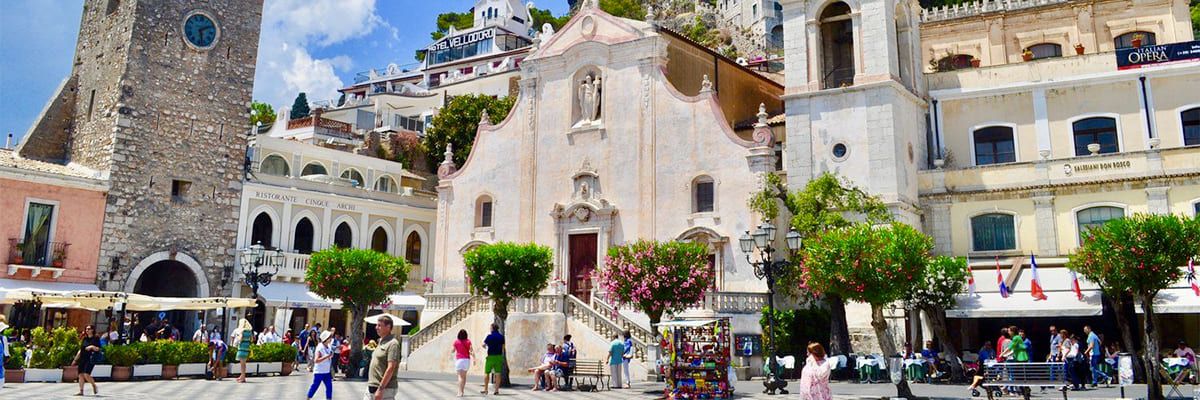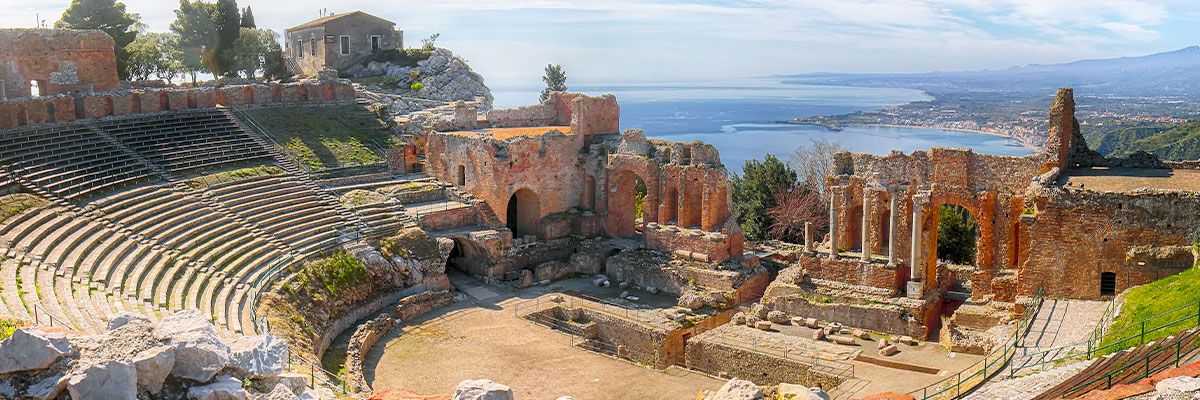Duomo - The Cathedral in Taormina

The first construction of the Duomo or Cathedral of Taormina dates back to the thirteenth century on the ruins of a church dedicated to St. Nicholas of Bari. Then, It was rebuilt in the fifteenth, sixteenth and eighteenth century.
The building looks more fortress than religious institution. This impression is accentuated by the construction made entirely with large stone blocks and finished with battlements along the whole perimeter of the building. The facade is adorned with a large rose window made of Siracusa stone of excellent workmanship. Two other rosettes on sides of the east and west of the church.
On the main facade, between two fifteenth-century ogival windows, we find the beautiful main door, which was rebuilt in 1636, by decision of the local administrator of the time, as it is shown on the slab of marble above the door. At each side of the main entrance there are two fluted columns in Corinthian style rising from high bases, and over the lintel there is a broken pediment; above the capitals of columns glimpsed the faces of two angels. Each doorjamb bears eleven carved figures These twenty-two characters represent St. Peter (keys of paradise), St. Paul (the sword of the Faith) King David (cither), the four evangelists in their characteristic symbols: the lion (Saint Mark), the eagle (St John), Taurus ( St Luke) and angel (St Matthew). The identification of other saints and apostles is not always so simple and obvious. At the top of each side of the marble frame there are two blessing bishops with mitre and pastoral. They are Saint Nicholas, the Titular Saint of the church and Saint Pancras, Taormina’s Patron Saint.
The side portals belong to different periods of time: the left is of the fifteenth century and presents a picture of the SS. Peter and Paul with the Blessing Christ in the architrave; the right portal is of the '500.
The interior is a Latin cross church with three naves and three apses. The nave is supported by six columns of pink marble of Taormina with the capitals with leaf motif and fish scale. It is thought that these may come from the greek-roman theater of Taormina. The ceiling is characterized by large wooden beams with carved shelves with Arab motifs rendered in Gothic style.
At each side of the main altar are two chapels worthwhile seeing:: on the left, the chapel of the Holy Sacrament, the end of '600, is in the Baroque style; on the right, one of Our Lady of Graces, was instead rebuilt in 1747 reusing the materials of a demolished Gothic chapel of St. Peter’s in Taormina.
In the right nave there is the Visitation of the Virgin Mary with Saints Joseph and Zechariah, painted by Antonino Giuffré in 1463.
In the same nave you can find a polyptych by Antonello de Saliba (1504), the first panel depicts the Madonna and Child with Saints Jerome and Sebastian, the second panel depicts the Pietà with Saints Lucy and Agatha, and the panel below depicts the Last Supper.
One of the most precious and oldest object of art and veneration kept in the Cathedral is the Byzantine Madonna. It is an Eastern-Orthodox-style oil-painted icon covered with a layer of silver incrusted with semi-precious stones.
In the left nave there is the Enthroned Virgin and Child between John the Baptist and the Prophet Elia and the lunette depicts the Eternal Father and the Crucifixion, painted on wood by Alfonso Franco (sixteenth century).
On the right nave, close to the entrance, there is a statue of St. Agatha, by Martino Montanini (sixteenth century).
From 1945 to 1948, the church was fully restored by the Neapolitan architect Armando Dillon, who strengthened the whole structure and brought to light the primitive structures of the arches of the apses, hidden with baroque stuccos. He also entirely rebuilt the original roof terraces on the aisles.
The church was elevated to the rank of Minor Basilica by Pope John Paul II on February 6, 1980 .
ADDRESS
Piazza Duomo, 1
PHONE: +39 0942 23123 / +39 339 5682372
TIMETABLE VISITS
From 8:30 to 20:00.
TIMETABLE MASSES
WINTER TIME
Working days: 18:00.
Holiday: 11:00, 18:00.
SUMMER TIME
Workind days: Ore 19:00, Agosto ore 20:00.
Holiday: Ore 11:00, 19:00, Giugno ore 11:00 (anche prefestivo) e 19:00, Luglio - Agosto ore 11:00 (anche prefestivo) e 20:00.
Rates
Free entrance.
LOCATION
Related articles
Palazzo Corvaja

IX Aprile Square

Greek Theatre


 English
English  Italiano
Italiano 















